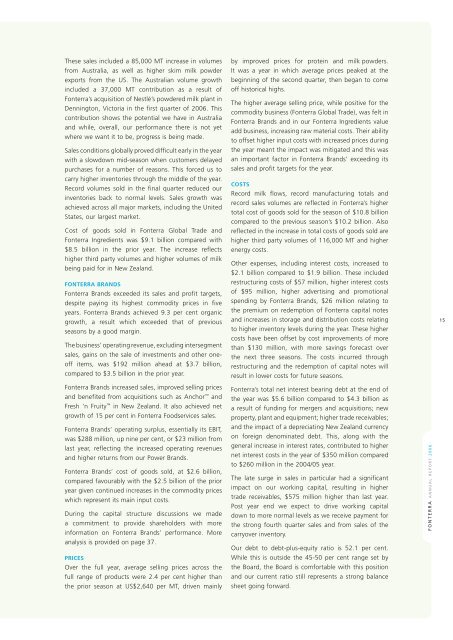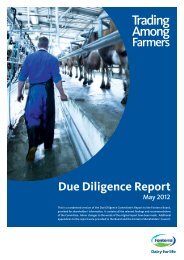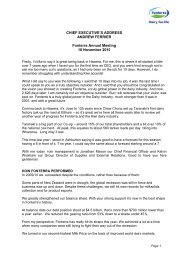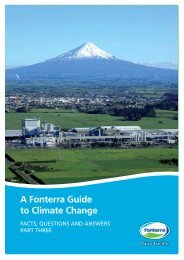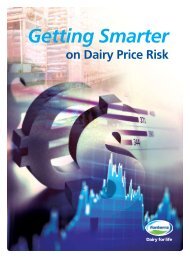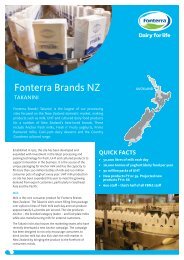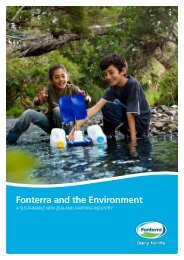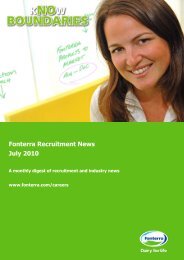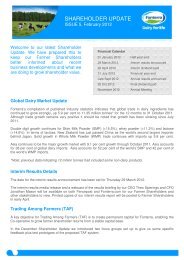F o n t e r r a
F o n t e r r a
F o n t e r r a
You also want an ePaper? Increase the reach of your titles
YUMPU automatically turns print PDFs into web optimized ePapers that Google loves.
These sales included a 85,000 MT increase in volumesfrom Australia, as well as higher skim milk powderexports from the US. The Australian volume growthincluded a 37,000 MT contribution as a result ofFonterra’s acquisition of Nestlé’s powdered milk plant inDennington, Victoria in the first quarter of 2006. Thiscontribution shows the potential we have in Australiaand while, overall, our performance there is not yetwhere we want it to be, progress is being made.Sales conditions globally proved difficult early in the yearwith a slowdown mid-season when customers delayedpurchases for a number of reasons. This forced us tocarry higher inventories through the middle of the year.Record volumes sold in the final quarter reduced ourinventories back to normal levels. Sales growth wasachieved across all major markets, including the UnitedStates, our largest market.Cost of goods sold in Fonterra Global Trade andFonterra Ingredients was $9.1 billion compared with$8.5 billion in the prior year. The increase reflectshigher third party volumes and higher volumes of milkbeing paid for in New Zealand.FONTERRA BRANDSFonterra Brands exceeded its sales and profit targets,despite paying its highest commodity prices in fiveyears. Fonterra Brands achieved 9.3 per cent organicgrowth, a result which exceeded that of previousseasons by a good margin.The business’ operating revenue, excluding intersegmentsales, gains on the sale of investments and other oneoffitems, was $192 million ahead at $3.7 billion,compared to $3.5 billion in the prior year.by improved prices for protein and milk powders.It was a year in which average prices peaked at thebeginning of the second quarter, then began to comeoff historical highs.The higher average selling price, while positive for thecommodity business (Fonterra Global Trade), was felt inFonterra Brands and in our Fonterra Ingredients valueadd business, increasing raw material costs. Their abilityto offset higher input costs with increased prices duringthe year meant the impact was mitigated and this wasan important factor in Fonterra Brands’ exceeding itssales and profit targets for the year.COSTSRecord milk flows, record manufacturing totals andrecord sales volumes are reflected in Fonterra’s highertotal cost of goods sold for the season of $10.8 billioncompared to the previous season’s $10.2 billion. Alsoreflected in the increase in total costs of goods sold arehigher third party volumes of 116,000 MT and higherenergy costs.Other expenses, including interest costs, increased to$2.1 billion compared to $1.9 billion. These includedrestructuring costs of $57 million, higher interest costsof $95 million, higher advertising and promotionalspending by Fonterra Brands, $26 million relating tothe premium on redemption of Fonterra capital notesand increases in storage and distribution costs relatingto higher inventory levels during the year. These highercosts have been offset by cost improvements of morethan $130 million, with more savings forecast overthe next three seasons. The costs incurred throughrestructuring and the redemption of capital notes willresult in lower costs for future seasons.15Fonterra Brands increased sales, improved selling pricesand benefited from acquisitions such as Anchor andFresh ‘n Fruity in New Zealand. It also achieved netgrowth of 15 per cent in Fonterra Foodservices sales.Fonterra Brands’ operating surplus, essentially its EBIT,was $288 million, up nine per cent, or $23 million fromlast year, reflecting the increased operating revenuesand higher returns from our Power Brands.Fonterra Brands’ cost of goods sold, at $2.6 billion,compared favourably with the $2.5 billion of the prioryear given continued increases in the commodity priceswhich represent its main input costs.During the capital structure discussions we madea commitment to provide shareholders with moreinformation on Fonterra Brands’ performance. Moreanalysis is provided on page 37.PRICESOver the full year, average selling prices across thefull range of products were 2.4 per cent higher thanthe prior season at US$2,640 per MT, driven mainlyFonterra’s total net interest bearing debt at the end ofthe year was $5.6 billion compared to $4.3 billion asa result of funding for mergers and acquisitions; newproperty, plant and equipment; higher trade receivables;and the impact of a depreciating New Zealand currencyon foreign denominated debt. This, along with thegeneral increase in interest rates, contributed to highernet interest costs in the year of $350 million comparedto $260 million in the 2004/05 year.The late surge in sales in particular had a significantimpact on our working capital, resulting in highertrade receivables, $575 million higher than last year.Post year end we expect to drive working capitaldown to more normal levels as we receive payment forthe strong fourth quarter sales and from sales of thecarryover inventory.Our debt to debt-plus-equity ratio is 52.1 per cent.While this is outside the 45-50 per cent range set bythe Board, the Board is comfortable with this positionand our current ratio still represents a strong balancesheet going forward.FONTERRA ANNUAL REPORT 2006


